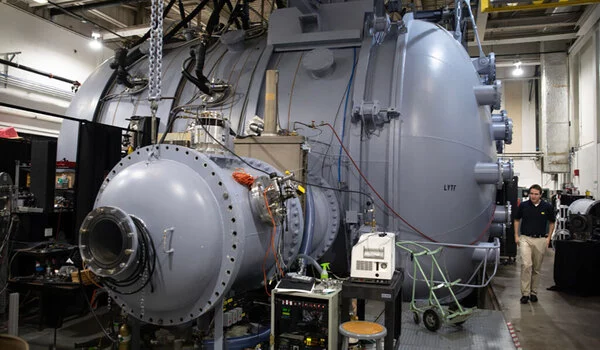In general, plasma thrusters can provide higher thrust-to-weight ratios and higher specific impulses than conventional chemical thrusters, making them an attractive option for satellite propulsion. One challenge with plasma thrusters is that they typically have lower thrust levels than chemical thrusters, which can limit their effectiveness for certain types of maneuvers. However, there are ongoing efforts to improve the performance of plasma thrusters, including the development of new designs and the use of advanced materials and manufacturing techniques.
Hall thrusters, an efficient type of electric propulsion widely used in orbit, were thought to need to be large in order to produce a lot of thrust. According to a new study from the University of Michigan, smaller Hall thrusters can generate significantly more thrust, potentially making them candidates for interplanetary missions.
“Previously, it was thought that you could only push a certain amount of current through a thruster area, which directly translates into how much force or thrust you can generate per unit area,” said Benjamin Jorns, a U-M associate professor of aerospace engineering who led the new Hall thruster study, which will be presented today at the AIAA SciTech Forum in National Harbor, Maryland.
His team tested this limit by increasing the power of a 9 kilowatt Hall thruster to 45 kilowatts while maintaining roughly 80% of its nominal efficiency. This increased the force generated per unit area by nearly a factor of ten.
We named our thruster the H9 MUSCLE because we basically took the H9 thruster and turned it up to 11 — really up to a hundred if we’re going by accurate scaling.
Leanne Su
Electric propulsion, whether referred to as a plasma thruster or an ion drive, is our best bet for interplanetary travel – but science is at a crossroads. While Hall thrusters are a well-proven technology, a magnetoplasmadynamic thruster concept promises to pack much more power into smaller engines. They are, however, unproven in many ways, including lifetime.
Because of the way they work, hall thrusters were thought to be uncompetitive. A powerful electric field accelerates the propellant, which is typically a noble gas such as xenon, as it moves through a cylindrical channel. As it exits the back, it generates thrust in the forward direction. However, before the propellant can be accelerated, it must lose some electrons in order to gain a positive charge.
Electrons accelerated by a magnetic field to run in a ring around that channel — described as a “buzz saw” by Jorns – knock electrons off the propellant atoms and turn them into positively charged ions. However, calculations suggested that if a Hall thruster tried to drive more propellant through the engine, the electrons whizzing in a ring would get knocked out of the formation, breaking down that “buzz saw” function.

“It’s like trying to bite off more than you can chew,” Jorns said. “The buzz saw can’t cut through that much material.” In addition, the engine would become extremely hot. Jorns’ team put these beliefs to the test.
“We named our thruster the H9 MUSCLE because we basically took the H9 thruster and turned it up to 11 — really up to a hundred if we’re going by accurate scaling,” said Leanne Su, a doctoral student in aerospace engineering who will present the study.
They tackled the heat problem by cooling it with water, which let them see how big a problem the buzz saw breakdown was going to be. Turns out, it wasn’t much trouble. Running with xenon, the conventional propellant, the H9 MUSCLE ran up to 37.5 kilowatts, with an overall efficiency of about 49%, not far off the 62% efficiency at its design power of 9 kilowatts.
They maxed out their power supply at 45 kilowatts while using krypton, a lighter gas. They achieved a maximum thrust of about 1.8 Newtons at an overall efficiency of 51%, which is comparable to the much larger 100-kilowatt-class X3 Hall thruster.
“This is an unusual result because krypton typically outperforms xenon on Hall thrusters. So it’s very cool and an interesting path forward to see that by increasing the thruster current density, we can actually improve krypton’s performance relative to xenon “Su stated.
Nested Hall thrusters, such as the X3 (also developed in part by U-M), have been investigated for interplanetary cargo transport, but they are much larger and heavier, making human transport difficult. Now, ordinary Hall thrusters are back on the table for crewed journeys.
According to Jorns, if Hall thrusters are to operate at these high powers, a space-worthy solution to the cooling problem is required. Nonetheless, he believes that individual thrusters with 100 to 200 kilowatts of power could be arranged into arrays with a megawatt of thrust. This could allow crewed missions to travel 250 million miles to Mars, even on the far side of the sun.
The team hopes to investigate the cooling issue as well as the difficulties in developing both Hall thrusters and magnetoplasmadynamic thrusters on Earth, where few facilities are available to test Mars-mission-level thrusters. The amount of propellant emitted by the thruster is too rapid for the vacuum pumps to maintain space-like conditions inside the testing chamber.
















